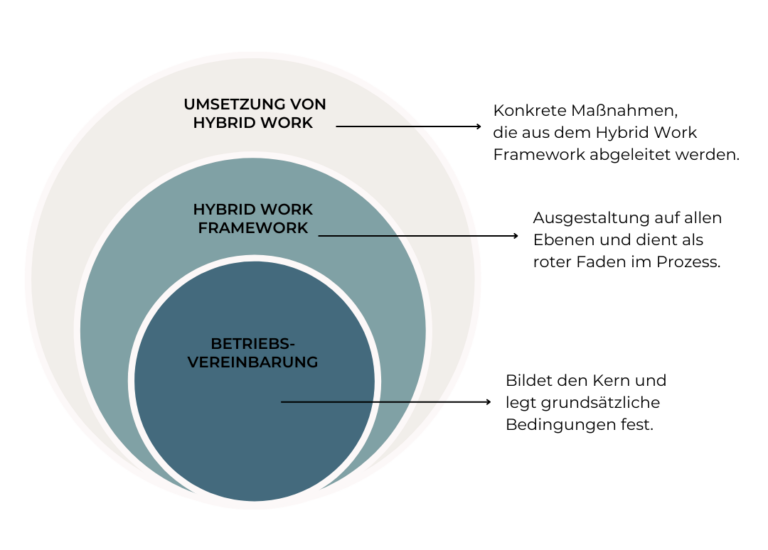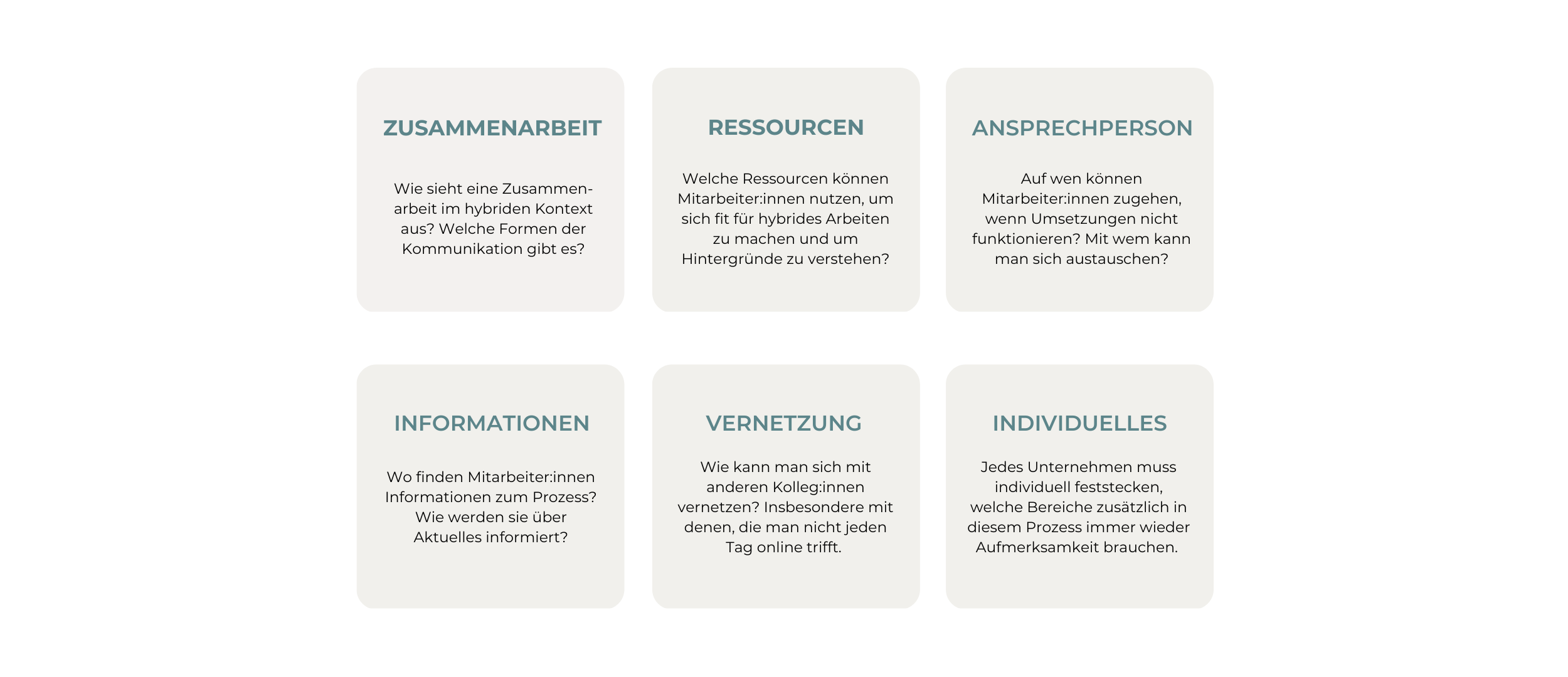
To successfully introduce hybrid working models into an organization, two things are needed. First, the introduction process must be based on a clear purpose of the company. Second, it requires the design of a hybrid work framework that serves as a common thread that guides the organization through the process. How exactly is a new work model introduced? And what is a Hybrid Work Framework?
Implementing Hybrid Work - where do you start?
Once the decision has been made in favor of a hybrid work model, the first challenge immediately arises. How do you successfully integrate new forms of collaboration into a company - at all levels? In the first instance, this question is easy to answer: By taking measures that correspond to the purpose of the organization. In the best case, the decision for such a working model has already been made on the basis of this purpose and not out of a compulsion to follow the masses. The question of concrete measures must therefore be preceded by the question of "why". How much freedom do we want to give our employees and why? Does a high degree of personal responsibility and self-management fit in with our corporate philosophy? For many, this means a change of perspective.
What about company agreements?
I am asked one question very often during initial consultations. "We have a company agreement on mobile working, isn't that enough?" And I always have my unequivocal answer ready. No, the company agreement is not sufficient for establishing a new working model. To continue as before - with a few more freedoms in the form of home office on top - it is. However, this is not about a new work model and certainly not about hybrid work. The company agreement is the skeleton and regulates the basic framework. The Hybrid Work Framework puts the flesh on the bones and fills the whole thing with life - at all levels.

Introduction of a hybrid working model
We have developed a blueprint for the introduction of hybrid work models based on four steps. This process is described in Roadmap to Hybrid in more detail.
Step 1
In the first phase, fundamental questions must be clarified and decided. Do we need a new working model at all? A symptom analysis is very helpful here. In this way, it can be clearly determined where there is a need for action. In addition, it must be determined which quantitative improvements are expected. Decisions must be made about the introduction process, for example, who will be part of the core team, how internal communication will take place and to what extent employees will be involved.

Step 2
The second step is an assessment of the current situation in the management team with the involvement of the employees. A clear decision must be made about the latter. Will a minimum approach be used, for example with data from employee surveys, or a maximum approach, i.e., distinct co-creation processes? The measures must be designed and clearly prioritized. With the Hybrid Work Assessment the factors for a hybrid work environment can be made measurable. The status quo is recorded with the help of the index and measures are taken on the basis of key figures.
Step 3
Measures are planned and implemented operationally. In the process, additional stakeholders must be identified and responsibilities and timelines defined. This phase of the introduction process is a good time to tie in an employer branding campaign.
Step 4
And finally: Go live! Normally, this is a step-by-step process where very clear communication is essential. What are fixed rules and what are experiments with open results? Rule of thumb: Strategic and conceptual decisions are more fixed, infrastructure and tools are more playful.
The four steps are a process and not every measure will be a complete success or meet with enthusiasm among employees when first implemented. Establishing Hybrid Work is not a project that must be completed within a specific timeframe. There will be test loops to measure success and there will certainly be a need to tighten things up in one place or another. Perhaps many experiments will fail, but that is part of the process. It is important to involve the employees, to communicate openly and to make the process transparent.
The introduction process needs stability and orientation
A Hybrid Work Framework forms the orientation framework and regulates the direction in which things are steered. I am often asked the question: "But does everything always have to be regulated? In practice, it's much easier if each team decides for itself."
In this case, the answer is yes. Hybrid Work is a complex work model that is still unknown to many and therefore needs to be approached very thoughtfully. A complex work model meets a complex organization that is affected by the new form of work at all its levels. Just going for it, without any strategy at all, can have serious consequences: Loss of credibility with employees, loss of trust, high costs and chaos. This must be avoided with a framework.
The Hybrid Work Framework helps organizations to identify and address all relevant areas when implementing a hybrid work model. In addition, the framework creates a balance between organizational interests and the interests of the individual or individual team. I refer to it as a guideline or orientation framework. And this framework provides stability and planning security, which is important for many in VUCA times.
Design of a Hybrid Work Framework
During consultations, I usually encounter question marks at first when I mention a Hybrid Work Framework. Which areas belong to this framework?

The exact composition of the different areas is determined by each company for itself. There is no generally applicable common thread when introducing a hybrid working model.
Another one of those feel-good projects?
Creating a framework requires time, people and knowledge. What does this effort bring to your organization? Quite a lot, as a study by McKinsey proves. Employees in organizations with clearly communicated rules for post-covid collaboration perform up to 4.5 times better than employees in organizations that do not have rules or do not communicate them. Employees also have an improved sense of belonging to their team and the organization as a whole.
A framework can also be a clear advantage in onboarding processes. Questions from applicants about mobile work, home office, remote work are now the norm in job interviews. With a clearly elaborated framework, it is possible to credibly and authentically convey how work is done in the organization. A Hybrid Work Framework is therefore a perfect occasion to talk about the cultural fit of an applicant.
